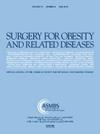Comparable results 5 years after one anastomosis gastric bypass compared to Roux-en-Y gastric bypass: a propensity-score matched analysis
IF 3.5
3区 医学
Q1 SURGERY
引用次数: 0
Abstract
Background
Previous studies comparing one anastomosis gastric bypass (OAGB) and Roux-en-Y gastric bypass (RYGB) are often limited by retrospective designs, or in randomized controlled trials, by small sample sizes or limited follow-up durations.
Objectives
This study aims to compare OAGB and RYGB during 5 years of follow-up in terms of weight loss, remission of comorbidities, and complications.
Setting
This longitudinal prospective study includes all patients who underwent a primary OAGB or RYGB between 2015 and 2016 in the Netherlands, utilizing data from the nationwide registry, Dutch Audit for Treatment of Obesity.
Methods
A 1:1 propensity-score matched (PSM) comparison between patients with OAGB and RYGB.
Results
After 1:1 PSM, 2 nearly identical cohorts of 860 patients were obtained. OAGB was associated with more intraoperative complications (2.0% versus .6%; P = .031). Conversely, RYGB had a higher rate of short-term complications (7.6% versus 3.8%; P < .001). Five-year data were available from 40.7% of the patients with OAGB and 34.9% with RYGB. No significant differences were observed in percentage total weight loss after 5 years (30.0% after OAGB and 28.8% after RYGB; P = .099). The total remission rate of diabetes mellitus was 60.5% for OAGB and 69.4% for RYGB (P = .656). However, OAGB resulted in a significantly higher remission rate of hypertension compared to RYGB (60.2% versus 45.5%; P = .015).
Conclusions
OAGB and RYGB yield comparable weight loss outcomes. However, OAGB had more intraoperative complications, while RYGB had more short-term complications. Both procedures show similar efficacy in diabetes mellitus remission, but OAGB is more effective in achieving hypertension remission.
单吻合胃旁路术与 Roux-en-Y 胃旁路术术后 5 年的效果比较:倾向分数匹配分析。
背景:以往比较单吻合口胃旁路术(OAGB)和Roux-en-Y胃旁路术(RYGB)的研究通常受限于回顾性设计,或在随机对照试验中受限于样本量小或随访时间有限:本研究旨在比较 OAGB 和 RYGB 在 5 年随访期间的体重减轻、合并症缓解和并发症情况:这项纵向前瞻性研究包括 2015 年至 2016 年期间在荷兰接受初治 OAGB 或 RYGB 的所有患者,利用的数据来自全国范围的肥胖症治疗登记--荷兰肥胖症治疗审计:对OAGB和RYGB患者进行1:1倾向得分匹配(PSM)比较:结果:经过 1:1 PSM 比对后,获得了两个几乎相同的队列,共 860 名患者。OAGB 与更多的术中并发症相关(2.0% 对 .6%;P = .031)。相反,RYGB 的短期并发症发生率更高(7.6% 对 3.8%;P < .001)。有 40.7% 的 OAGB 患者和 34.9% 的 RYGB 患者提供了五年的数据。5 年后总重量下降的百分比无明显差异(OAGB 后为 30.0%,RYGB 后为 28.8%;P = .099)。OAGB 和 RYGB 的糖尿病总缓解率分别为 60.5%和 69.4%(P = .656)。然而,与 RYGB 相比,OAGB 的高血压缓解率明显更高(60.2% 对 45.5%;P = .015):结论:OAGB 和 RYGB 的减肥效果相当。结论:OAGB 和 RYGB 的减肥效果相当,但 OAGB 的术中并发症较多,而 RYGB 的短期并发症较多。两种手术对糖尿病缓解的疗效相似,但 OAGB 对高血压缓解的疗效更好。
本文章由计算机程序翻译,如有差异,请以英文原文为准。
求助全文
约1分钟内获得全文
求助全文
来源期刊
CiteScore
6.70
自引率
12.90%
发文量
570
审稿时长
56 days
期刊介绍:
Surgery for Obesity and Related Diseases (SOARD), The Official Journal of the American Society for Metabolic and Bariatric Surgery (ASMBS) and the Brazilian Society for Bariatric Surgery, is an international journal devoted to the publication of peer-reviewed manuscripts of the highest quality with objective data regarding techniques for the treatment of severe obesity. Articles document the effects of surgically induced weight loss on obesity physiological, psychiatric and social co-morbidities.

 求助内容:
求助内容: 应助结果提醒方式:
应助结果提醒方式:


